Course
Imagine you are developing a self-driving car. To make the car "see" and understand the road, it must learn to recognize objects like pedestrians, traffic signs, and other vehicles. For this to happen, the car’s machine learning system requires thousands—if not millions—of images from real-world driving scenarios.
But the car can't inherently understand what's in the images. It doesn't know that a red octagon is a stop sign or that a person is walking on the sidewalk. This is where data annotation comes in.
Data annotation is the process of labeling raw data to make it understandable and usable for machine learning models. We’ll explain it in more depth later, but keep this in mind.
Here’s what we will explore in this article:
- Different types of data annotation
- Techniques used
- Available tools
- Best practices
- Challenges faced in this process
Let’s get into it!
What is Data Annotation?
The best way to think of data annotation is to think of what it’s like to teach kids different animals. At first, you show them a picture of a dog and say, “This is a dog.” Then you show them a cat and say, “This is a cat.” Over time, by showing them labeled examples, the child learns to identify animals independently. Data annotation works similarly for machines.
Just as a child requires labeled examples (note: saying “This is a dog” is the labeling), machine learning models require data to be annotated to learn from it. Thus, Data annotation is the process of labeling or tagging data, such as images, text, or audio, so that machine learning algorithms can recognize and understand it.
The labels serve as examples that teach the system what patterns to look for. For instance, if you annotate thousands of images with "dog" or "cat" labels, the model will start recognizing the differences between the two.
Once it has learned from these examples, the model can then make predictions or classify new unlabeled data, just as the child eventually recognizes animals without your help.
Types of Data Annotation
Different types of data require specific annotation methods to prepare them for machine learning tasks. Depending on the nature of the data, there are unique approaches for labeling and tagging. Understanding these types helps determine the most effective way to train models for a variety of applications.
Let's explore the most common types of data annotation:
Image annotation
Image annotation involves labeling images so that machine learning models can identify and interpret objects within them. Different techniques are used in image annotation, depending on the level of detail required:
Bounding boxes
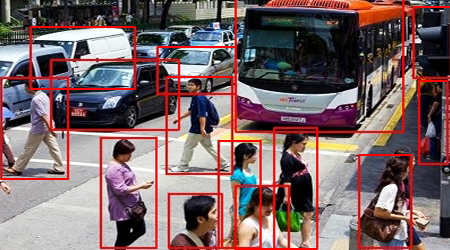
Bounding boxes. Source: Anolytics
This method involves drawing rectangles around objects in an image to help the model recognize their presence and location. Bounding boxes are commonly used to detect cars, pedestrians, or signs in self-driving technology.
Semantic segmentation

Semantic segmentation. Source: Introduction to Semantic Image Segmentation
Here, each pixel in an image is labeled to assign specific regions to particular objects or categories, like identifying roads, buildings, or trees. This technique gives the model a more granular understanding of the scene.
Landmark annotation

Landmark annotation. Source: Anolytics
This technique involves marking specific points within an image, such as facial features or key points in body posture. It's used in applications like facial recognition and human pose estimation.
Text annotation
Text annotation is the process of labeling and tagging text data to make it understandable for natural language processing (NLP) models. It enables machines to comprehend, process, and analyze human language.
There are several common techniques used in text annotation:
Entity recognition
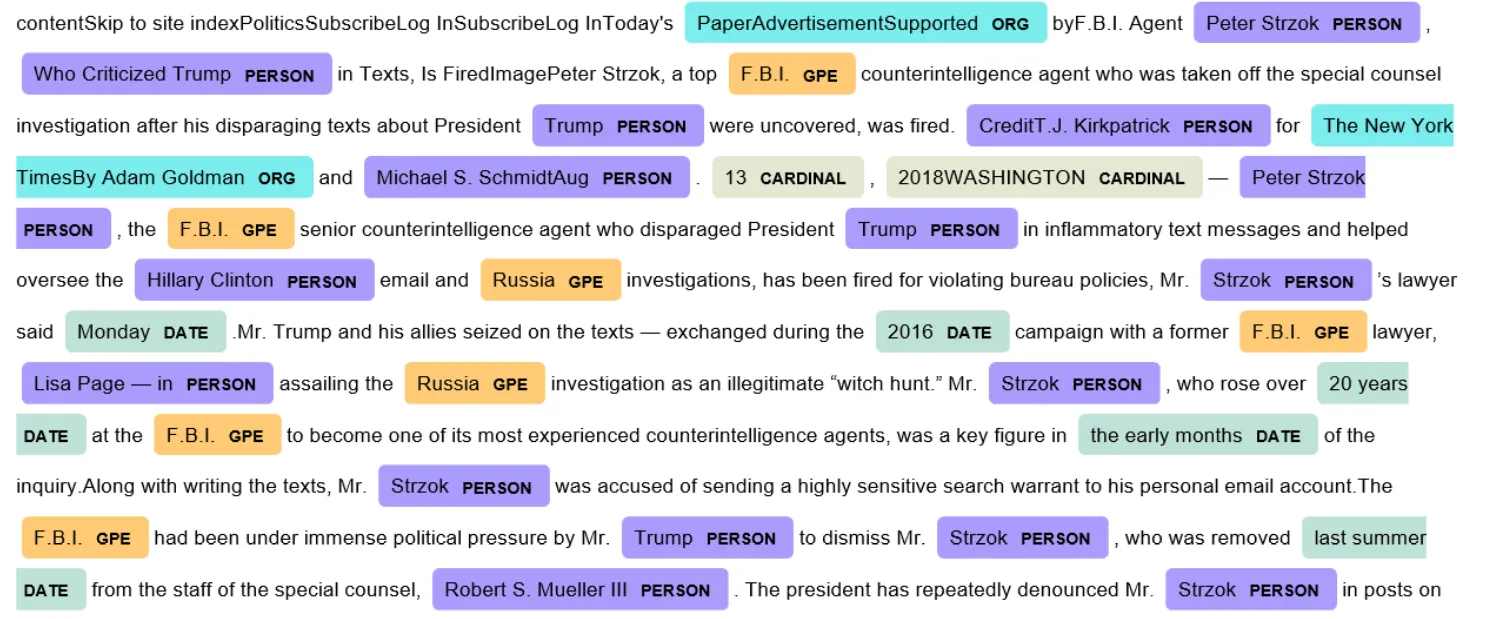
Entity recognition. Source: Named Entity Recognition and Classification with Scikit-Learn
This involves identifying specific entities in text, such as names of people, places, or organizations. For example, in the sentence "Apple opened a new store in New York," the model would recognize "Apple" as a company and "New York" as a location.
Sentiment tagging
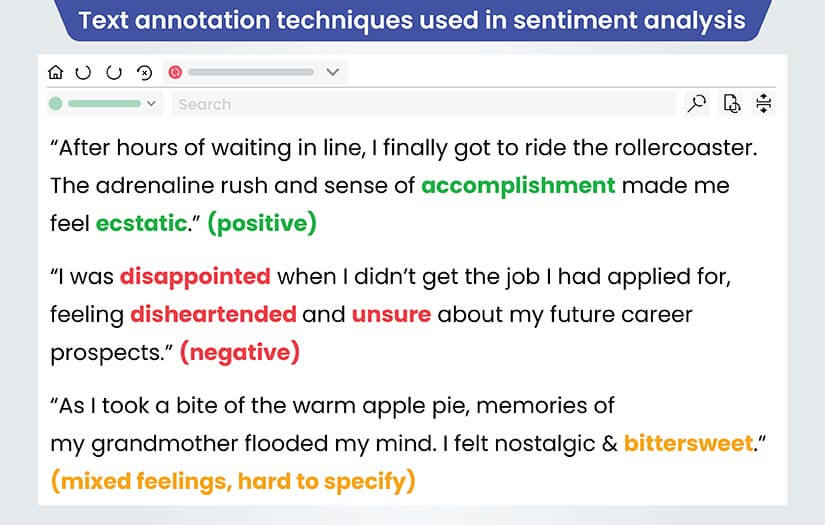
Sentiment tagging. Source: Understanding the text annotation process for Customer Sentiment Analysis
This technique assigns emotions or opinions to pieces of text, labeling them as positive, negative, or neutral. It’s often used in customer reviews or social media monitoring to understand how users feel about a product or service.
Part-of-speech tagging
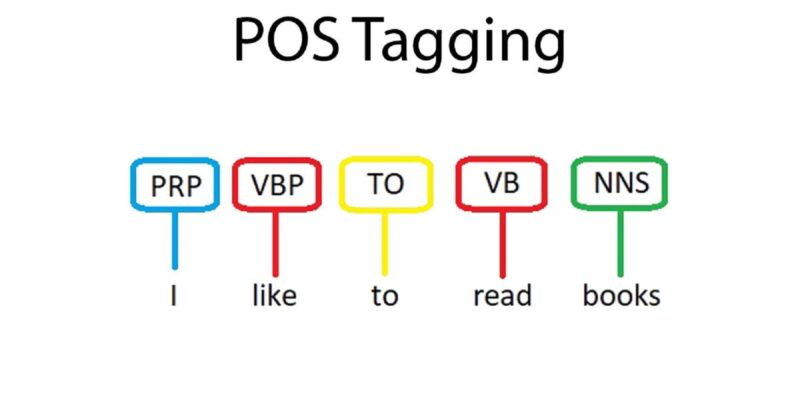
POS tagging. Source: POS tagging in NLP
This method labels each word in a sentence with its grammatical role (e.g., noun, verb, adjective), helping models understand language structure for tasks like translation or speech recognition.
Audio annotation
Audio annotation involves labeling sound files to train models for speech recognition, music detection, or sound classification.
Some common audio annotation techniques include:
Transcription
Converting spoken words in an audio file into written text is often used in speech-to-text applications.
Speech segmentation

Speech segmentation. Source: ResearchGate
This involves dividing an audio file into different sections. For example, you may want to separate dialogue from background noise or identify individual speakers in a conversation.
Sound tagging
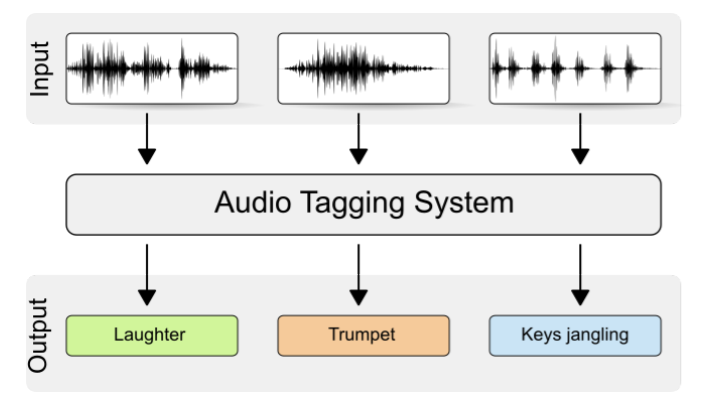
Sound tagging. Source: Freesound Tagging by VGGish with KNN
Sound tagging is when specific sounds (e.g., traffic noise, animal sounds, etc.) are labeled within an audio file.
Video annotation
Video annotation involves labeling and tagging objects or actions in video frames to help machine learning models interpret motion and activities.
Key video annotation techniques include:
Object tracking
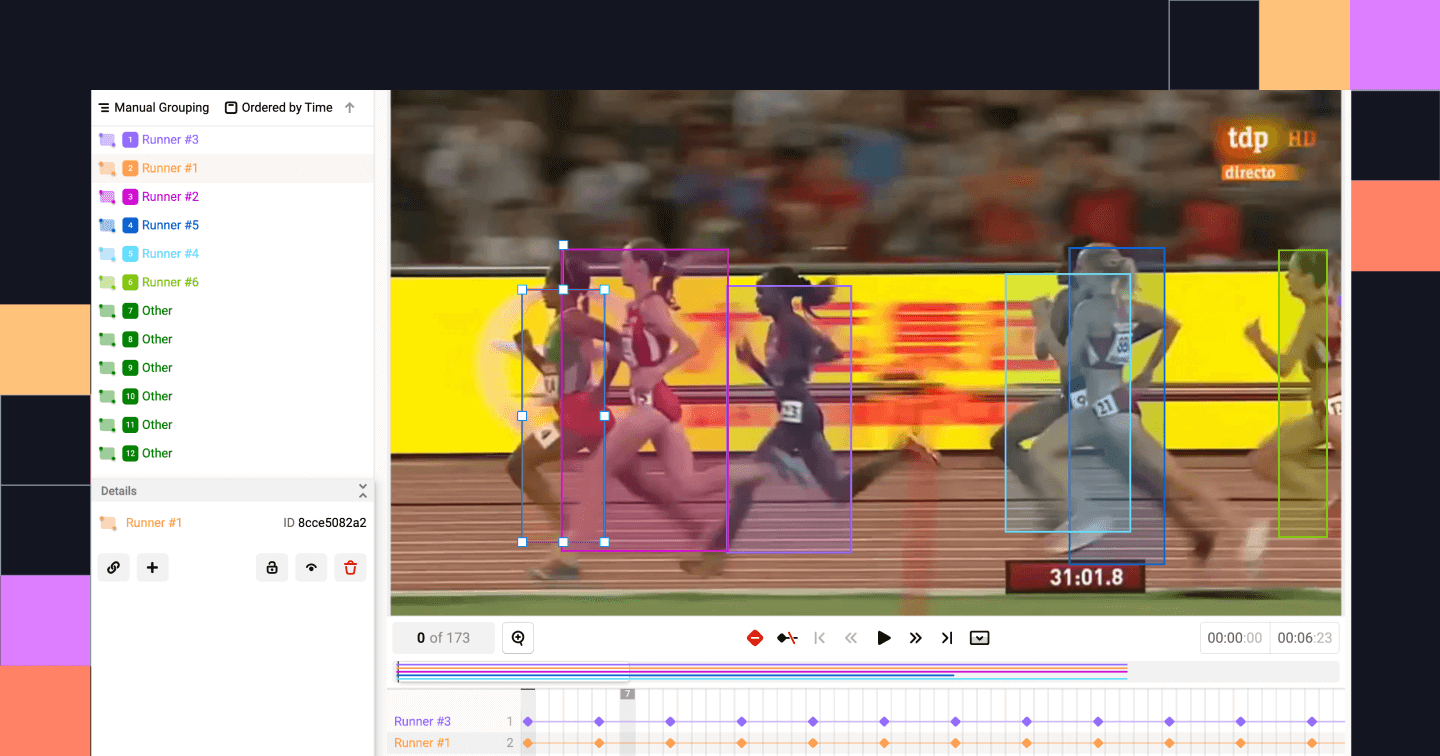
Object tracking. Source: Label Studio
Object tracking involves continuously labeling objects across multiple frames to track their movement. In autonomous driving scenarios, for example, one may use object tracking to follow a vehicle through a busy intersection.
Activity labeling
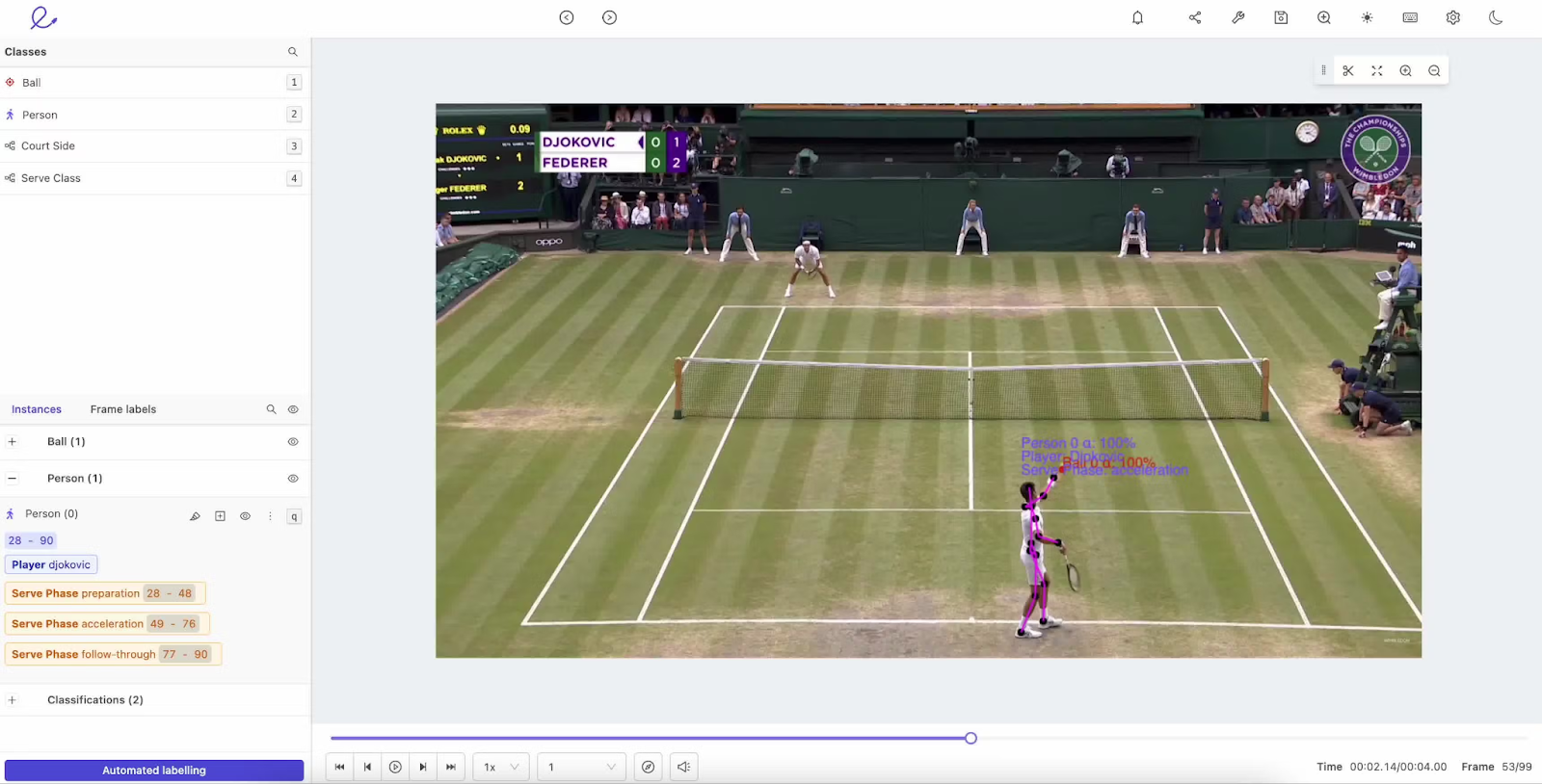
Activity labeling. Source: Encord
This is when labels are assigned to specific actions, like someone walking, running, or sitting down in a video. This helps models understand human behavior in applications like security monitoring or sports analytics.
Frame-by-frame annotation
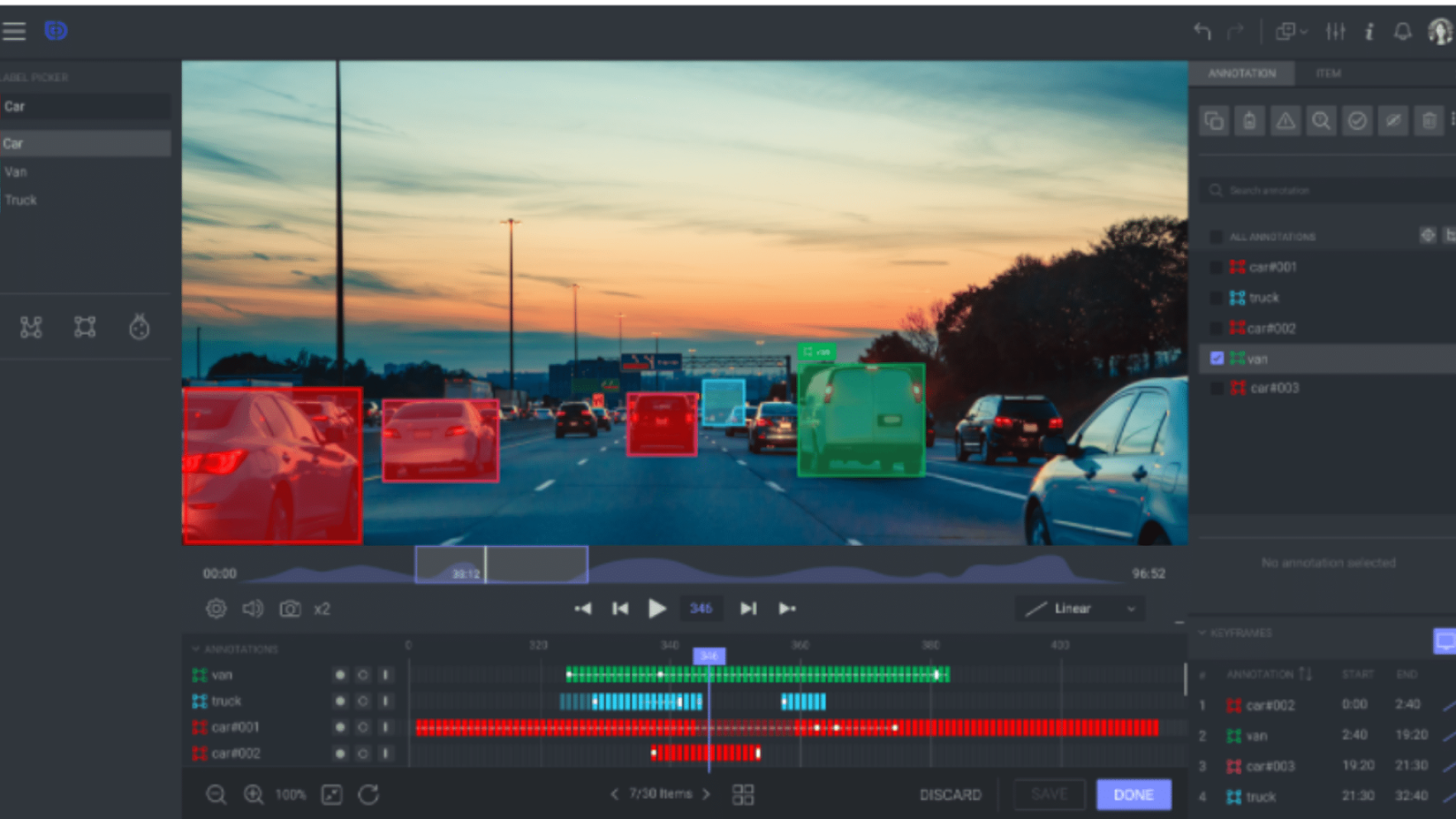
Frame-by-frame annotation. Source: dataloop
When each individual frame of a video is labeled to capture minute details, it’s called frame-by-frame detection. This is often used for tasks that require high precision, such as analyzing body movements in physical therapy.
Data Annotation Techniques
The method used to annotate data can vary depending on several factors, such as:
- The complexity of the project
- The size of the dataset
- The level of precision required
In other words, some tasks require the accuracy of human annotators, while others can benefit from automation to save time and scale the process. Below, we'll explore the various approaches to give you a better insight into what situation each should be used in.
Manual annotation
Manual annotation is when human annotators label data by hand. In this approach, trained annotators carefully review each piece of data and apply the necessary labels or tags.
The biggest advantage of manual annotation is accuracy. Since humans can understand context, nuance, and complex patterns better than machines, they can ensure the data is labeled precisely. This level of accuracy is especially important for projects that require high-quality, detailed annotations, such as medical image labeling or complex natural language tasks.
However, manual annotation also comes with significant challenges:
- Time-consuming: Manually annotating large datasets takes a lot of time, especially when the data is complex or extensive. For example, annotating thousands of images for a computer vision project can take weeks or months.
- Costly: Manual annotation is labor-intensive and often involves high costs, particularly when professional or expert annotators are required, such as for medical or legal data.
Despite these challenges, manual annotation remains essential for projects where precision is critical, even though businesses often look for ways to balance quality with time and cost efficiency.
Semi-automated annotation
Semi-automated annotation combines human expertise with machine learning assistance. In this approach, a machine learning model helps human annotators by pre-labeling the data or offering suggestions. The human annotators then review and refine the labels to ensure accuracy.
The benefit of semi-automated annotation is that it speeds up the process while still retaining a high level of accuracy. The machine can handle repetitive or simple tasks, which allows the human annotators to focus on more complex or ambiguous data points. This approach is ideal for large projects where full manual annotation would be too slow or expensive because it strikes a balance between time efficiency and quality control.
However, it faces certain challenges:
- Inaccurate model suggestions: The machine-generated labels may not always be accurate, requiring human annotators to spend extra time reviewing and correcting errors.
- Ongoing human involvement: Despite the automation, human oversight is still necessary, which can slow down the process, especially for complex data.
- Initial setup time: Setting up and training the model to produce helpful suggestions can take time, and poor initial results may reduce the benefits of automation in the early stages.
Semi-automated annotation works best for projects that need to balance quality with speed, where the data is complex enough to benefit from human review but large enough to require machine assistance.
Automated annotation
Automated annotation uses machine learning algorithms to label data without human involvement. In this approach, pre-trained models or AI-driven tools automatically annotate large datasets. This makes the process faster and more scalable than manual or semi-automated methods.
The main advantage of automated annotation is its efficiency. It can process vast amounts of data in a fraction of the time it would take a human annotator. As a result, automated annotation is an ideal solution for projects with huge datasets, like tagging millions of images for a computer vision model or transcribing large volumes of audio for speech recognition.
But the drawbacks of relying on machines are as follows:
- Lower accuracy: Automated systems can make mistakes, particularly with ambiguous, noisy, or highly varied data. This results in lower-quality annotations compared to human-labeled data.
- High setup costs: Developing or purchasing AI-driven tools and training them to perform accurate annotations often requires significant investment, both in terms of cost and time.
- Limited handling of complex data: Automated annotation struggles with tasks that require an understanding of context or nuance, such as interpreting emotional tone in text or identifying subtle visual details in images.
Automated annotation is best suited for projects that require speed and scalability but where a certain margin of error is acceptable or when human review can be used later to refine the results.
Crowdsourcing
Crowdsourcing involves distributing data labeling tasks to a large number of contributors using platforms like Amazon Mechanical Turk or Appen. This method enables businesses to quickly and cost-effectively annotate large datasets by tapping into a global pool of workers.
One of the main advantages of crowdsourcing is scalability. Distributing tasks to many contributors enables companies to handle large volumes of data efficiently. For instance, a project requiring thousands of labeled images or transcriptions can be completed in days rather than weeks or months.
The downsides of this approach are as follows:
- Inconsistent quality: Since contributors may have different skill levels and attention to detail, the quality of annotations can vary. Businesses may need to employ quality control measures, such as having multiple people annotate the same data or reviewing a portion of the work for accuracy.
- Limited to simpler tasks: Crowdsourcing is most effective for straightforward annotation tasks that don’t require deep expertise. Complex tasks, such as labeling medical images or legal texts, may be beyond the capabilities of non-expert contributors.
- Coordination and management: Managing large numbers of contributors can be difficult. Ensuring consistency, setting clear guidelines, and maintaining data privacy are essential but challenging when dealing with crowdsourced labor.
Crowdsourcing is ideal for large-scale projects that require fast and cost-effective annotation. However, maintaining high-quality results requires strong oversight and task management.
Tools for Data Annotation
There are a wide range of tools available for data annotation. These tools range from open-source platforms to comprehensive commercial solutions that are each designed to meet different project needs.
For example, open-source tools are often customizable and free to use. This makes them them ideal for smaller projects or teams with technical expertise. On the other hand, commercial options provide more advanced features, including automation, collaboration tools, and quality control, which makes them better suited for large-scale projects or enterprises looking for a streamlined workflow.
In this section, we'll explore some of the most popular tools available for data annotation and how they can help with different types of data:
Labelbox
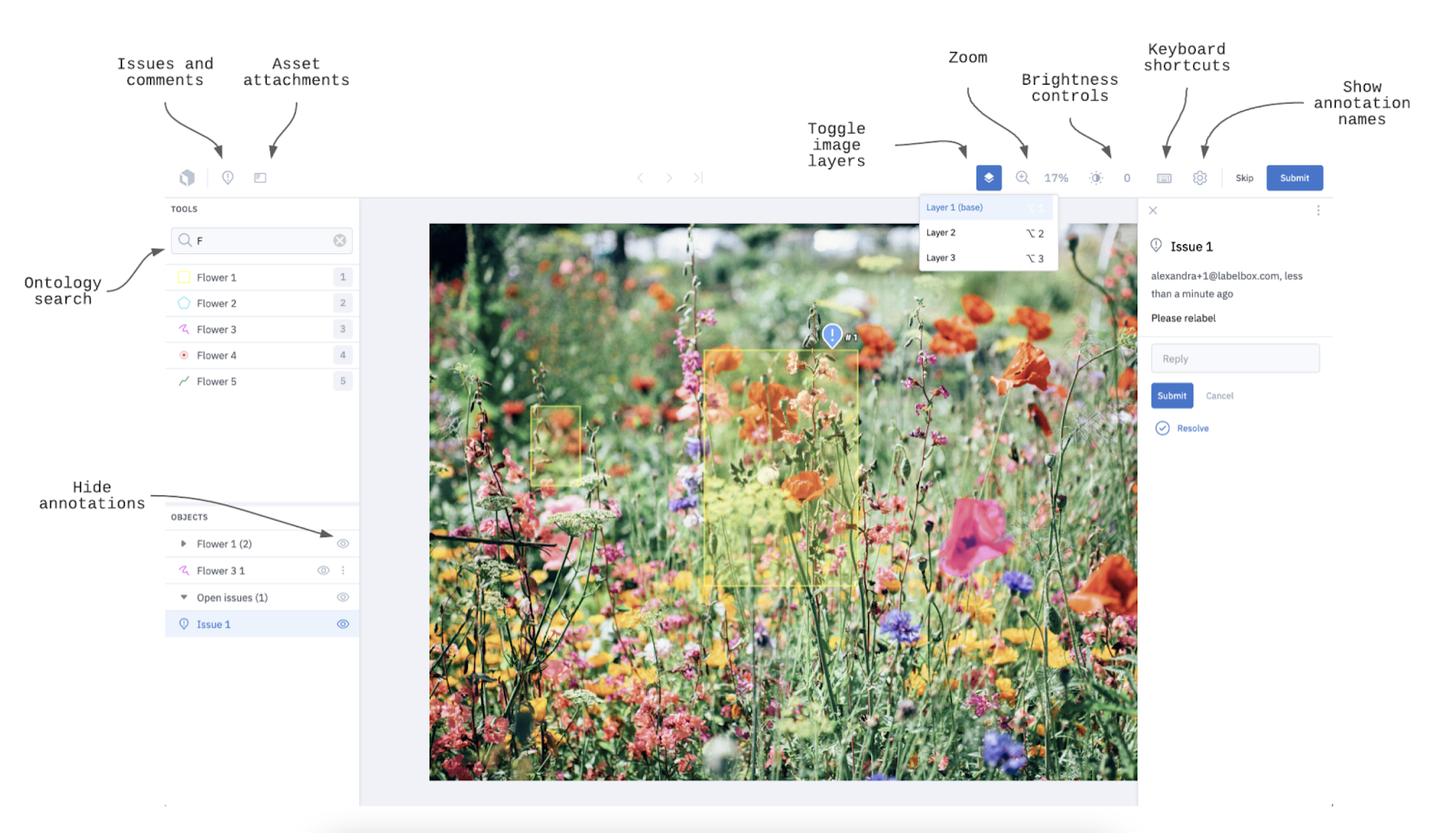
Source: Labelbox Docs
Labelbox is a widely used commercial platform designed to streamline the data annotation process, focusing on collaboration and quality control. It was founded in 2018 by Manu Sharma, Brian Rieger, and Peter Welinder, whose mission is “to build the best products to align with artificial intelligence.”
The Labelbox platform provides an intuitive interface where teams can collaborate to annotate data, track progress, and maintain high annotation standards. It also supports a variety of data types (e.g., images, video, and text), which makes the platform extremely versatile for different machine learning projects.
One of its key features is its built-in quality control mechanisms, which enable teams to review and approve annotations—this ensures consistent and accurate results.
Labelbox is ideal for organizations looking to scale up their annotation efforts with integrated project management and automation features.
CVAT (Computer Vision Annotation Tool)
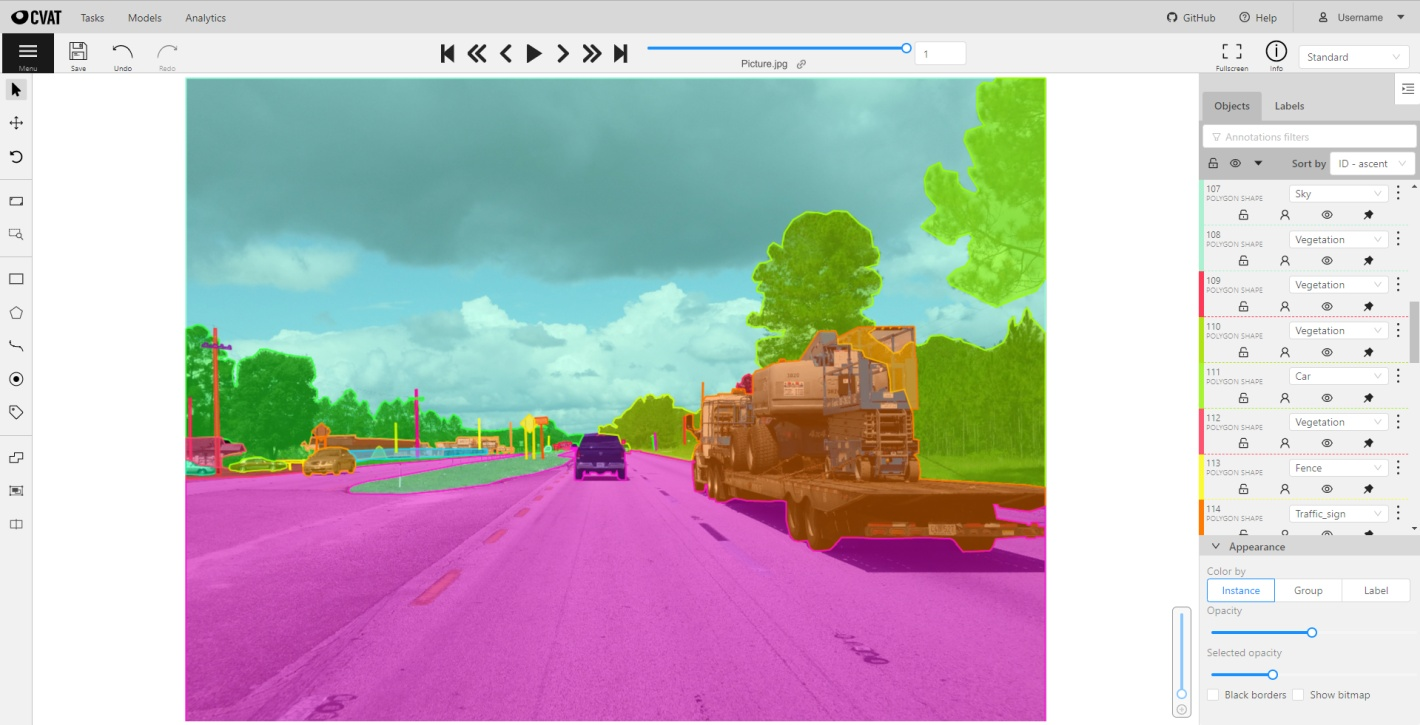
Source: CVAT Wikipedia page
CVAT is an open-source tool specifically designed to annotate image and video datasets. Developed by Intel, CVAT is highly customizable and offers a wide range of annotation techniques (e.g., bounding boxes, polygons, and keypoint annotations). Its flexibility makes it suitable for projects ranging from object detection to facial recognition.
Because it’s open-source, CVAT is free to use and can be tailored to meet specific project needs. This makes it a popular choice for researchers and smaller teams that need powerful annotation tools without the cost of commercial software.
Prodigy
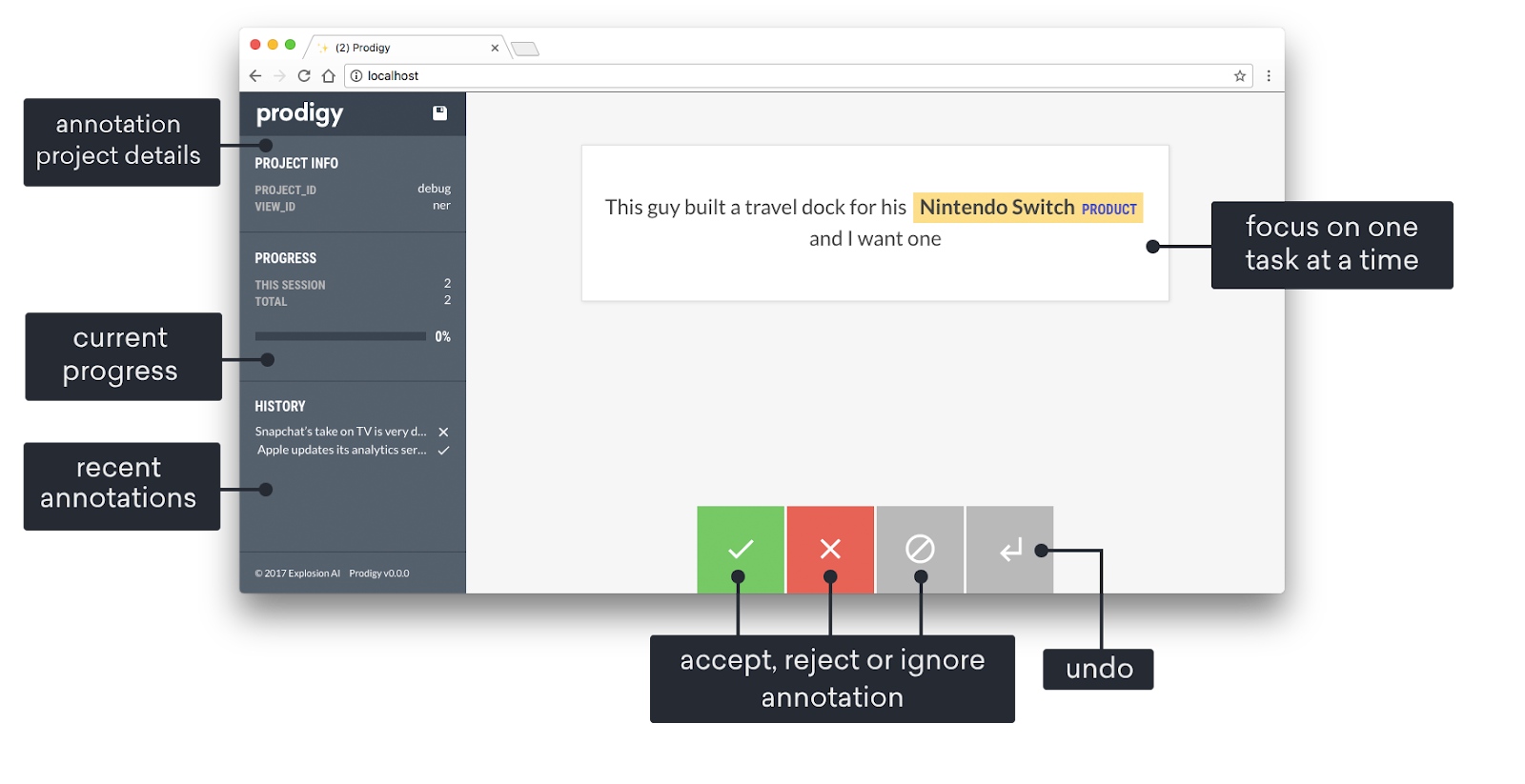
Source: Prodigy Docs
Prodigy is an advanced annotation tool developed by Explosion AI that uses active learning to improve efficiency, particularly in natural language processing (NLP) tasks. With Prodigy, a machine learning model assists annotators by suggesting labels based on their predictions, which are then confirmed or corrected by human reviewers.
This interactive approach speeds up the annotation process while simultaneously ensuring the labeled data is of high quality. Despite being a commercial tool, Prodigy is highly customizable; for example, it allows users to create their own annotation workflows. These factors make Prodigy highly suitable for teams working on specialized NLP projects like sentiment analysis, entity recognition, or text classification.
Amazon SageMaker Ground Truth
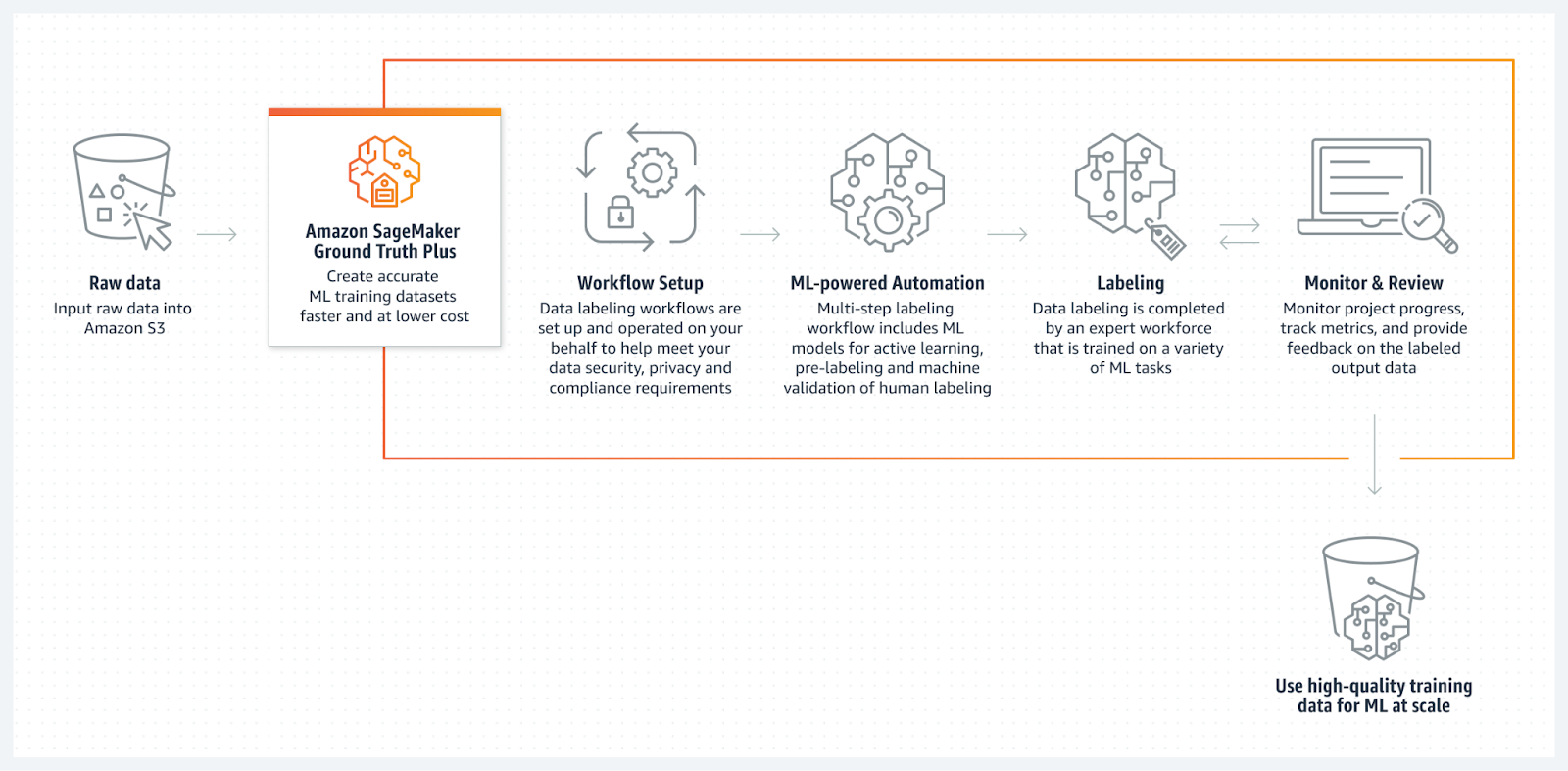
Source: Amazon SageMaker Ground Truth
Amazon SageMaker Ground Truth is a fully managed data labeling service that integrates seamlessly with AWS. It provides tools for manual and automated data annotation that allow users to label data quickly and accurately.
SageMaker Ground Truth uses machine learning to assist human annotators by pre-labeling data, which speeds up the process and reduces costs. The service is also an extremely versatile option for different machine learning tasks as it supports a wide variety of data types, including images, text, and videos.
Additionally, it’s built to scale, which means it’s a strong option for enterprises that require large-scale annotation capabilities within the AWS ecosystem.
Other tools to consider
- LabelImg: An open-source tool specifically for image annotation. It allows users to create and edit bounding boxes for object detection.
- VGG Image Annotator (VIA): A lightweight and easy-to-use tool for annotating images and videos, ideal for researchers or small projects that need basic annotation functionality.
- Dataloop: A commercial platform that combines annotation tools with data management and automation features, suitable for teams that require scalable annotation workflows with integrated AI capabilities.
Best Practices for Data Annotation
Effective data annotation is critical to the success of machine learning models, as the quality of labeled data directly impacts the accuracy of predictions and classifications. Following best practices can help ensure that the annotation process is both efficient and reliable.
In this section, we’ll explore essential practices that can enhance the quality and consistency of data annotation while also addressing challenges one may face in the labeling process.
Define clear annotation guidelines
One of the most important steps in the data annotation process is creating clear, well-defined guidelines. These guidelines should specify exactly how data should be labeled and what criteria annotators should follow for consistency.
Clear guidelines help to:
- Minimize ambiguity
- Reduce errors
- Ensure that all annotators are on the same page
Having standardized rules in place is particularly crucial for complex or subjective data, such as images or text with multiple possible interpretations.
Quality assurance
Quality is necessary to maintain the accuracy and reliability of annotated data. Thus, annotated data must be periodically reviewed to ensure it meets the required standards. This process may be conducted through random audits, using multiple annotators for the same tasks (to compare results), or cross-checking annotations, depending on the project.
The main gist is that it is vital to implement a robust quality assurance process to help you catch errors early, reduce bias in your data, and ensure the labeled data is suitable for training high-performing machine learning models.
Leverage active learning
Active learning is a machine learning technique that allows an algorithm to select the most informative data samples for labeling, which improves the model's performance. This technique can significantly improve the efficiency of the annotation process. It allows annotators to focus their time and energy on the most challenging and valuable data points, while the machine learning algorithm suggests the rest.
This approach reduces the time spent on labeling easy or repetitive samples, and accelerates the overall annotation process. Thus, it increases the odds the machine learning model being used to make predictions is trained on the most critical examples.
Ensure annotator training
To ensure that the annotation process is carried out accurately, annotators should receive proper training. Training helps annotators understand the specific requirements of the task and how to apply the annotation guidelines correctly.
Well-trained annotators are more likely to produce high-quality labeled data, which ultimately improves the performance of the machine learning models they are supporting. Regular training sessions and feedback loops can also help refine annotator skills over time, further enhancing the data annotation process.
Challenges in Data Annotation
While data annotation is essential for training accurate machine learning models, the process comes with its own set of challenges. In this section, we will discuss some of the most common challenges in data annotation.
Cost and time constraints
Manual data annotation is often labor-intensive. A significant amount of time and financial resources is required to annotate all instances, especially when the dataset is large. The more complex the data (such as video or intricate images), the more time-consuming the annotation process becomes. Skilled annotators must be hired, which increases the costs.
To overcome this challenge, organizations can use semi-automated annotation tools, where machine learning models suggest labels and humans verify them. This speeds up the process without sacrificing accuracy.
Active learning can also help by focusing human effort on the most informative data, which reduces the total amount of data to be manually labeled. Additionally, using crowdsourcing platforms like Amazon Mechanical Turk allows multiple contributors to work simultaneously, which means large-scale annotation can be more affordable and efficient.
Subjectivity and bias
Another key challenge is dealing with subjectivity and bias in the annotation process. Different annotators may interpret the same data in varying ways. This is extremely common for tasks like labeling emotions in text or identifying objects in complex images. The problem with this is that subjectivity can introduce bias into the labeled data, which in turn can lead to biased model predictions.
To reduce subjectivity and bias, organizations should create clear, detailed annotation guidelines that ensure all annotators follow the same criteria. Another solution is to use multiple annotators for the same data, which allows cross-checking and helps identify and correct biased or inconsistent annotations.
Data privacy concerns
Annotations that reveal identifying information can violate privacy regulations that protect personal data. This challenge is particularly significant when outsourcing annotation tasks or using crowdsourcing platforms, where many contributors have access to the data.
Solutions such as anonymization (removing personally identifiable information) and using secure, encrypted platforms for annotation can help mitigate these risks.
Real-World Applications of Data Annotation
In this section, we'll explore the real-world applications of data annotation. Let’s get into it!
Autonomous vehicles
In autonomous vehicles, data annotation is the foundation for teaching AI to safely navigate the real world. Self-driving cars rely on annotated data to identify objects.
For example, annotators label images or video frames by drawing bounding boxes around cars or marking road boundaries for lane detection. These annotations help the AI learn how to recognize and react to various road scenarios, such as stopping for pedestrians or staying in the correct lane.
Healthcare
AI models require labeled medical images to learn how to detect abnormalities. For example, skilled annotators would outline specific areas on images to mark regions that show early signs of cancer. This enables AI to quickly and accurately detect cancer earlier than traditional methods, which improves patient outcomes and reduces the workload for medical professionals.
Customer service chatbots
For customer service chatbots, text annotation is critical for teaching AI how to understand human language.
For example, annotators may label text to help chatbots recognize user intent. The chatbots would then analyze the labeled interactions to help them learn how to provide the appropriate responses. This enables organizations to offer quicker and more accurate assistance and improve the customer experience.
Sentiment analysis
In sentiment analysis, text annotation is used to gauge how customers feel about certain things (e.g., the brand, products, or events). The way this works is that annotators would tag phrases or sentences as positive, negative, or neutral, and then this data is passed to AI to learn the underlying sentiment. A company may then deploy this to monitor how customers are receiving a new product launch.
Conclusion
Data annotation is the process of labeling data to make it recognizable and usable for machine learning models. It is a critical step in developing AI systems that can accurately interpret and respond to real-world data. Why? Because the quality and accuracy of annotated data directly impact the performance and effectiveness of AI models.
Ultimately, data annotation serves as the foundation for building intelligent, reliable AI systems that can drive innovation across various industries. This makes it an indispensable part of machine learning development.
To continue your learning, check out the following resources:
AI Upskilling for Beginners
FAQs
What is the difference between data annotation and data labeling?
The terms are often used interchangeably, but "data annotation" is broader and may include tasks like tagging, classification, or segmentation, while "data labeling" often refers to assigning specific values to data points.
Why is high-quality data annotation critical for AI success?
High-quality annotation ensures that machine learning models learn from accurate, relevant data, which directly affects their ability to make correct predictions or classifications.
How do companies ensure consistency in data annotation?
Companies use detailed annotation guidelines, regular training sessions for annotators, and quality control processes like cross-verification or consensus checks to maintain consistency.
Can data annotation be outsourced safely?
Yes, but it requires secure platforms, data anonymization, and clear contracts to ensure data privacy, especially in sensitive industries like healthcare or finance.
How does active learning improve the data annotation process?
Active learning allows models to request annotations on uncertain data points, helping annotators focus on the most valuable examples and improving the overall training dataset efficiency.
What are some free tools for data annotation?
Popular free tools include CVAT, LabelImg, and VGG Image Annotator (VIA). These open-source tools are widely used in academic and research projects.
Which industries benefit the most from data annotation?
Data annotation is crucial in industries such as healthcare, automotive (especially autonomous vehicles), retail, finance, and customer service.
Is crowdsourcing reliable for complex data annotation tasks?
Crowdsourcing is best for simple tasks. Complex or sensitive data often requires domain expertise and should be handled by trained professionals to ensure accuracy.
What is semantic segmentation in data annotation?
Semantic segmentation involves labeling each pixel in an image with a category, enabling machine learning models to understand detailed visual structures like roads, trees, or buildings.
How do annotation errors affect machine learning models?
Annotation errors can lead to biased or inaccurate models, reducing their performance and potentially causing real-world consequences, especially in critical applications like medical diagnosis or autonomous driving.






